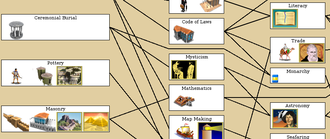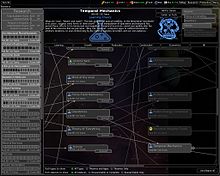Technology tree

Instrategy games,atechnology,tech,orresearch treeis ahierarchicalvisual representation of the possible sequences of upgrades a player can unlock (most typically representing theresearchprogress of a given faction). Because these trees are technically directed and acyclic, they can more accurately be described as adirected acyclic graphof technologies. The diagram istree-shaped in the sense that it branches between each 'level', allowing the player to choose one sequence or another.[1]Each level is called atierand is often used to describe the technological strength of a player. Typically, at the beginning of a session of a strategy game, a player will start at tier 1, which offers only a few options for research. Each technology that a player researches will normally open up one or more new options, but may also, depending on the computer game, close off the paths to other options. The tech tree is the representation of all possible paths of research a player can take, up to the culmination of said sequence.
A player who is engaged in research activities is said to be "teching up", "going up the tech tree", or "moving up the tech tree". Analysis of a tech tree can lead players to memorize and use specificbuild orders.
Types
[edit]Classic research
[edit]The Classic tech tree is the one where extensive research into new technologies must be conducted parallel to the progression of a game. Somereal-time strategy(RTS) games as well as mostturn-based strategy(TBS) games employ this type of tech tree. In these games, players typically have a 'command center', 'unit-training-facility' and 'research facility' at their disposal from the start, allowing them to both start research into more advanced technologies, or engaging in combat with enemies using the basic units (Warzone 2100,Mega Lo Mania,Master of Orionseries,Civilizationseries,Space Empiresseries).
Allocation
[edit]In some games, the requirement of an actual research facility is absent. In this case players can allocate research points, or in-game resources to purchase new technologies. In some games the allocation yields direct results, meaning that procuring the new technology isn't paired with allotted time for the research of said technology to complete.
Building-based
[edit]In most RTS games the technology tree consists of buildings which must be built in a specific sequence, which in turn unlocks new technologies. These newly unlocked technologies can be more advanced units, upgrades for research or more advanced buildings. (StarCraft,Command & Conquerseries.)
Prerequisites for technology advances
[edit]In most types of strategy games, the player needs particular buildings in order to research specific technologies or build specific advanced units (StarCraft,Total Annihilation), while in other games upgrades/technologies are unlocked through research alone (Warzone 2100). In many TBS games the prerequisite is one or more lower-level technologies, with no dependency on specific buildings (Master of Orionseries,Civilizationseries,Space Empiresseries).[2][3][4]
Complexity
[edit]
The structures of tech trees vary quite widely. In the simplest cases (e.g.Master of Orion) there are several completely separate research areas and one could research all the way up to the highest level in one area without researching other areas (although this would often be far from ideal). In more complex cases[citation needed](e.g.Civilization) every technology above the starting level has more than one prerequisite and one has to research most of the lower-level technologies in order to research any of the top-level technologies. And there are many possibilities between these two variants, for example inSpace Empiresresearching to a specified level in one field may enable the player both to research to a higher level in that fieldandto start research in a new field which was previously not available.[2]
Major4Xgames likeCivilizationandMaster of Orionhave a much larger technology tree than most other strategy games; as an extreme example,Space Empires IIIhas over 200 technologies.[5][6]
Availability of technologies
[edit]
Some RTSs make different techs available to different races or cultures (especiallyStarCraft;but many RTSs have special units or buildings for different cultures, e.g.Age of Empiresexpansion pack and later versions,Red Alert 2). Most TBSs make all technologies available to all cultures (e.g.Civilization).Master of Orion(original version) is a complex special case in this respect: the full tree is the same for all; but in each game each player gets a subset of the full tech tree that depends on which race was selected.
Balance between civilian and military techs
[edit]In many RTS games tech advances are almost exclusively military (e.g.StarCraft). But in most TBS and some RTS games the research and production costs of top-end military techs are so high that you have to build up your economy and your research productivity first (RTS –Age of EmpiresandEmpire Earth,where one of the most significant costs is going up an epoch; TBS – theCivilizationseries andMaster of Orionseries).
What happens after researching everything
[edit]In many games there's nothing useful to do and the player may scrap research centers to save maintenance costs and/or devote the resources to something else (Space Empiresseries).
In later installments of theCivilizationseries the last technology (called "future tech" ) represents an amalgamation of all possible future discoveries and can be researched repeatedly. InCivilization V,it increases a player's score, while inCivilization IVit raises the health and the happiness in the empire. Note that to reach the last technology in Civilization V, all spaceship technologies required to win must also have been discovered, so the game will likely be nearing its conclusion.
In theGalactic Civilizationsseries the final technology solves the nature of existence, andisvictory.
In theMaster of Orionseries more advanced research reduces the size and cost of spaceship components, and "hyper-advanced" research in areas which have military applications therefore enables players to build more high-tech weapons into a given ship size and at lower production cost.
InRise of Nations,the final four technologies result in such an advantage that the game will likely end quickly. Also, the "knowledge" resource needed to research is also used late in the game to produce cruise missiles and nuclear weapons.
History
[edit]Typically the board gameCivilizationbyFrancis Tresham(1980) is given the credit of introducing a technology tree.Sid Meier’s Civilization(1991) is considered as an iconic computerturn-based strategygame for using them. SinceCivilization,technology trees have been used in various digital games.[7]Likewise, the first creation of a technology tree as a mechanism refers toCivilization.[8]
The arcade shoot 'em upGradiusused a power-up system functionally identical to a tech tree in 1985[citation needed].
Tech trees started showing up inturn-based strategygames in the early 1990s[citation needed].The 1991 video gameMega Lo Maniahad a tech tree with a system of research levels/epochs that allowed the deployment of better units and defences and is considered to be the first game to combine a technology tree into aReal-time strategygame.
See also
[edit]References
[edit]Citations
[edit]- ^Rollings, Andrew; Ernest Adams (2006).Fundamentals of Game Design.Prentice Hall.
- ^abSee the relevant games' manuals.
- ^Master of Orion(1993), theGalactic Civilizationsseries andSword of the Starshave no research buildings; players simply allocate some of each colony's output to research (see game manuals). In theCivilizationseries (1991 onwards) andMaster of Orion II(1996) one can do research without buildings, but it's much faster when supported by the right buildings (see game manuals). In theSpace Empiresseries (1993 onwards) and inAscendancy(1995) research can only be done via buildings, but these can research any technology (see game manuals).
- ^"RTS Basics: R & D".and theStarCraftmanual. Although multi-epoch games like theAge of EmpiresandEmpire Earthseries have a larger number of research options and a significant proportion of civilian research options, the research options all depend on having the right buildings. See the relevant games' manuals.
- ^"Joystiq interview: Ironclad talks 4X strategy with Sins of a Solar Empire".February 1, 2008.Retrieved2008-06-14.
- ^InWarcraft IIIone can reach the highest level of one branch of the technology tree in five steps;Master of Orion(original version) has 10 levels per subject, and 2 to 5 technologies per level; theCivilization IVtechnology tree requires nearly 60 steps to reach the end (see game manuals).
- ^Heinimäki 2015,p. 21.
- ^Ghys, Tuur."Technology Trees: Freedom and Determinism in Historical Strategy Games".gamestudies.org.Retrieved13 November2017.
Sources
[edit]- Heinimäki, Teemu J. (2015).Technology Trees and Tools: Constructing Development Graphs for Digital Games - dissertation(PDF).Vol. 1349.Tampere,Finland:Tampere University of Technology.ISBN9789521536335.
